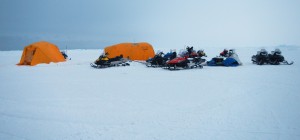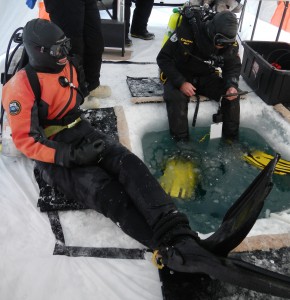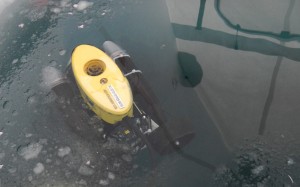Scientists test under-ice research tools in Beaufort Sea
March 19, 2013
907-474-7208
3/14/13

Enter ingenuity and technology: A research team from the University of Alaska Fairbanks School of Fisheries and Ocean Sciences spent four days camped on the ice near Barrow testing several ways of collecting data from under the ice.
The team, led by project manager Lorena Edenfield, cut two 4-foot square holes in the ice to experiment with data-collection techniques, including gill nets, sonar and a remotely operated vehicle. Divers, under the direction of chief scientist Brenda Konar, also tested standard SCUBA gear and a rebreather unit, which is a breathing apparatus that recirculates oxygen and eliminates escaping air bubbles.

"We didn't catch any fish, which is disappointing, but with that aside, everything that we put down worked and we didn't have any problems," said Edenfield, "It was a really successful way to test if the stuff is feasible on the ice in this extreme environment - and it was."
The pilot study is a component of the larger, "Central Beaufort Sea Marine Fish Monitoring" research project funded by the Bureau of Ocean Energy Management and managed by principal investigator Brenda Norcross.
The research team included Edenfield, Konar, and graduate student Sarah Traiger from UAF, Mark Barton from Florida State University, and diver Rob Robbins, as well as an ROV operator from Global Diving & Salvage in Anchorage. Local bear guards and laborers were hired through UMIAQ, who provided logistical support for the project.
The field work, originally scheduled for Feb. 28 through March 4, wrapped up on March 3, a day early due to inclement weather and unsafe conditions at a third research site.

"We had three different holes drilled in the ice, but we were only able to sample in two of them. We got to the third site and there was a crack through the ice, so we came back to town," said Edenfield, "But that's okay, because that was the day it was white-out conditions with a windchill of minus 55."
The next steps for the project will be compiling a report for BOEM, which will eventually be publicly available, and to use the results of the pilot study to plan for future under ice projects. Norcross has another BOEM-funded project that includes more under ice survey work for 2014 near Kaktovik.
ADDITIONAL CONTACTS: Lorena Edenfield, 907-474-7938, leedenfield@alaska.edu
ON THE WEB: www.sfos.uaf.edu
NOTE TO EDITORS: Photos are available for download at www.uafnews.com.
SW/3-19-13/229-13


